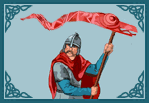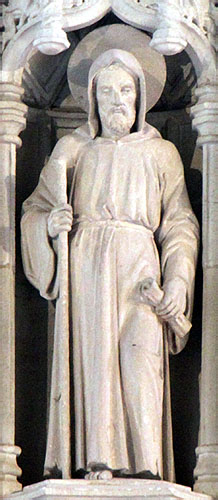 |
 |
|||
|
|
St. Cennydd was said to be the son of Prince Deroch II of Domnonée, through an incestuous relationship with his own daughter. While the poor girl was pregnant, Deroch was summoned by the High-King Arthur to attend the Christmas festivities being held at his court in Aber Llychwr (Loughor). The two journeyed there together and Cennydd was probably born at nearby Caer Gynydd in Waunnarlwydd. He was born a cripple, with the calf of one leg attached to the thigh. A priest managed to baptise the infant, giving it the name of Cennydd, before Deroch ordered his son to be thrown into the river. Cennydd was placed in an osier-woven cradle and launched into the Lliw. This stream speedily carried it down to the River Llwwchwr (River Loughor) and that swept it out to sea. A storm arose and drove the cradle, dancing on the crest of the waves, to Ynys Weryn (Worm's Head), where it was cast up on the beach. At once a cloud of seagulls fluttered over the baby Cennydd and carried him to the top of a rock. There they stripped their breasts of feathers to make a bed for him. The birds kept constant watch over their little protégé, spreading their wings over him to shelter him from wind and rain and snow. Before nine days had passed, an angel descended from heaven, bearing a brazen bell, which he applied to the mouth of the infant, who chewed vigorously at the handle, like a teething ring. Thus Cennydd lived until he was old enough to walk, and the garments in which he had been wrapped when exposed, grew with him, expanding, as does the bark of a tree. One day, a peasant farmer who lived near the sea, and who had no family, happened to light upon the child. He took Cennydd up, carried him home and gave him to his wife, who at once put the little boy to bed. This caused tremendous anxiety and excitement among the gulls. They arrived in vast numbers, dividing themselves into two flocks. One group entered the house and pulled the coverlet off the sleeping Cennydd. The other group, with the aid of beak and claw and screeching cries, drove the farmer's cattle towards the sea. Alarmed for his livestock, the man hastily carried Cennydd back to where he had found him. Thereupon the gulls drove his cattle back to their pastures and, in the most tidy manner, replaced the coverlet on the bed. By this time, Cennydd was being sustained by a hind, which came to him daily out of the forest and squirted her milk into the bell that the boy employed as his feeding-bottle. She likewise filled hollows in the nearby rocks. Cennydd continued this diet, supplemented by roots and herbs, until he reached the age of eighteen. Then an angel, who had been instructing him in Christian teachings, informed him that he must depart to a reedy spot, later called Llangennydd (Llangennith), about a mile distant. Cennydd started on his way, but made slow progress on account of his crippled condition. He halted some twenty-four times, and at each stop a miraculously spring erupted to quench his thirst. At last, Cennydd arrived at his destination. There he built himself a hut of woven osiers, roofed with reeds, and acquired himself a servant. One day, nine robbers, who infested the district, visited Cennydd in order to see what they might steel from him. However, they left their weapons outside and were hospitably entertained. Meanwhile, Cennydd's servant coveted one of their spears and stole it. When the robber asked for his lance, the servant swore that he had not seen it: "Bring out the bosom-shaped bell and I will take oath on that." Having thus forsworn himself, Cennydd's servant went mad and ran away to the remote areas around Mynyw (St. Davids). There he lived like a wild beast, till the hair of his body completely covered him. After seven years, Cennydd prayed for his restoration and the man returned to his service as a sincere penitent. Later, King Morgan of Glywysing (or an early monarch) went raiding in the region around Llangennydd (Llangennith), gathering together much plunder. The hermit thereupon sent his servant with the woman-breasted bell to demand a share of the spoil. He, naturally, met with refusal and abuse. Then the plunderers began to quarrel among themselves over the division of the spoil. They came to blows and many were killed. Morgan, attributing this disaster to the offence given to Cennydd and his disregard for the sanctity of his bell, went to him and offered compensation. The King took Cennydd up onto the hillside and, looking out across his kingdom, granted the saint as much land as he desired. When SS. Dewi, Teilo and Padarn travelled through Wales in 545, summoning the country's abbots and bishops to the Council of Llanddewi Brefi, they stopped at St. Cennydd's cell and were hospitably received. Dewi requested that he attend the synod. However, showing them his crippled leg, Cennydd explained that he could not possibly undertake such a journey. So St. Dewi prayed for his relief and Cennydd's contracted leg was relaxed, so that he could walk as any other man. This did not please Cennydd, however, who wished to remain as God had originally intended. He therefore prayed for the restoration of his deformity and, at once, up went his limb as before and the calf again adhered to the thigh. Consequently, he did not attend the Synod, but he did expand his contact with the outside world by establishing a monastery around his hermitage. At some point, Cennydd returned to his parents' homeland, founding churches and chapels at Ploumelin, Saint-Caradec, Plaintel (where his stone 'bed' may be seen) and Languidic, his main residence in Brittany. He settled at this last place, after having being pursued by a small band of five warriors. He prayed for deliverance and they were miraculously turned to stone. They remain as a row of standing stones now called the 'Soldiers of St. Cornelius', but once the 'Soldiers of St. Cennydd'. St. Cennydd died on 1st August probably at some time in the late 6th century. At Llangennydd (Llangennith), however, his feast day is 5th July. Records of St. Cennydd only date back to the 14th century. He is generally considered legendary.
|
|||
| © Nash Ford Publishing 2006. All Rights Reserved. | ||||





 St. Cennydd
St. Cennydd